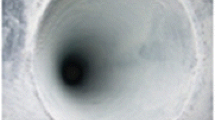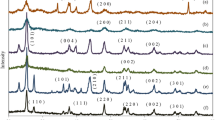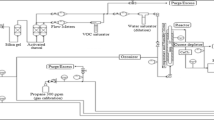Abstract
Heterogeneous photocatalysis is highlighted to treat volatile organic compound (VOC) emission. Then, this work analysed the influence of palladium (Pd) content loaded in TiO2 on n-octane and iso-octane photodegradation. For this, TiO2 was loaded with Pd in different contents: 0.4%, 0.7%, and 1.0%. The samples were characterized, and the photodegradation experiments were conducted by Pd/TiO2/UV process. The characterization analyses showed that the metal presence did not change the catalyst structure or its surface area; however, it reduced the bandgap energy. The photocatalytic results proved that palladium improved n-octane degradation from 62% (pure TiO2) to 92.6% (0.4%Pd/TiO2) and, iso-octane degradation enhanced from 59% (pure TiO2) to 90.6% (0.7%Pd/TiO2); all results were obtained in the space time of 39 s. Therefore, 0.4%Pd/TiO2 and 0.7%Pd/TiO2 showed better oxidation results to degradation n-octane and iso-octane, respectively. The kinetic model of pseudo-first order showed a good fit for the data of both VOCs. Heterogeneous photocatalysis with Pd/TiO2 showed to be an adequate technique to reduce VOCs emission.






Similar content being viewed by others
Availability of data and materials
The datasets used and/or analysed during the current study are available from the corresponding author on reasonable request.
References
Abou Saoud W, Kane A, Le Cann P et al (2021) Innovative photocatalytic reactor for the degradation of VOCs and microorganism under simulated indoor air conditions: Cu-Ag/TiO2-based optical fibers at a pilot scale. Chem Eng J 411:128622. https://doi.org/10.1016/J.CEJ.2021.128622
Alberici RM, Jardim WF (1997) Photocatalytic destruction of VOCs in the gas-phase using titanium dioxide. Appl Catal B Environ 14:55–68. https://doi.org/10.1016/S0926-3373(97)00012-X
Assadi AA, Bouzaza A, Wolbert D, Petit P (2014) Isovaleraldehyde elimination by UV/TiO2 photocatalysis: comparative study of the process at different reactors configurations and scales. Environ Sci Pollut Res 21:11178–11188. https://doi.org/10.1007/s11356-014-2603-7
Assadi AA, Loganathan S, Tri PN et al (2018) Pilot scale degradation of mono and multi volatile organic compounds by surface discharge plasma/TiO2 reactor: Investigation of competition and synergism. J Hazard Mater 357:305–313. https://doi.org/10.1016/J.JHAZMAT.2018.06.007
Atkinson R (2000) Atmospheric chemistry of VOCs and NO_x. Atmos Environ 34:2063–2101. https://doi.org/10.1016/S1352-2310(99)00460-4
Belver C, López-Muñoz MJ, Coronado JM, Soria J (2003) Palladium enhanced resistance to deactivation of titanium dioxide during the photocatalytic oxidation of toluene vapors. Appl Catal B Environ 46:497–509. https://doi.org/10.1016/S0926-3373(03)00291-1
Çankaya S, Pekey H, Pekey B, Özerkan Aydın B (2020) Volatile organic compound concentrations and their health risks in various workplace microenvironments. Hum Ecol Risk Assess an Int J 26:822–842. https://doi.org/10.1080/10807039.2018.1539638
Doubek ÚLR (2018) Influência de parâmetros de projeto em reatores fotocatalíticos para tratamento de compostos orgânicos voláteis. Universidade Estadual de Campinas
Espindola JDS (2010) PRODUÇÃO FOTOCATALÍTICA DE HIDROGÊNIO A PARTIR DE SOLUÇÕES DE ETANOL EM ÁGUA. Universidade federal do Rio Grande do Sul
Fujimoto TM, Ponczek M, Rochetto UL et al (2017) Photocatalytic oxidation of selected gas-phase VOCs using UV light, TiO2, and TiO2/Pd. Environ Sci Pollut Res 24:6390–6396. https://doi.org/10.1007/s11356-016-6494-7
Jacobson MZ (2012) Air pollution and global warning: history, science, and solutions, 2nd edn. Cambridge Universisty Press, Cambridge
Kuvarega TA, Krause WMR, Mamba BB (2011) Nitrogen/palladium-codoped TiO2 for efficient visible light photocatalytic dye degradation. J Phys Chem C 115:22110–22120. https://doi.org/10.1021/jp203754j
Li FB, Li XZ (2002) The enhancement of photodegradation efficiency using Pt–TiO2 catalyst. Chemosphere 48:1103–1111. https://doi.org/10.1016/S0045-6535(02)00201-1
Li Z, Meng X (2020) Recent development on palladium enhanced photocatalytic activity: A review. J Alloys Compd 830:154669. https://doi.org/10.1016/j.jallcom.2020.154669
Meng A, Zhang L, Cheng B, Yu J (2019) Dual Cocatalysts in TiO2 Photocatalysis. Adv Mater 31:1807660. https://doi.org/10.1002/adma.201807660
Nagaveni K, S. Hegde M, Ravishankar N, et al (2004) Synthesis and structure of nanocrystalline TiO2 with lower band gap showing high photocatalytic activity. Langmuir 20:2900–2907. https://doi.org/10.1021/la035777v
Naldoni A, D’Arienzo M, Altomare M et al (2013) Pt and Au/TiO2 photocatalysts for methanol reforming: role of metal nanoparticles in tuning charge trapping properties and photoefficiency. Appl Catal B Environ 130–131:239–248. https://doi.org/10.1016/j.apcatb.2012.11.006
Ohtani B, Prieto-Mahaney OO, Li D, Abe R (2010) What is Degussa (Evonik) P25? Crystalline composition analysis, reconstruction from isolated pure particles and photocatalytic activity test. J Photochem Photobiol A Chem 216:179–182. https://doi.org/10.1016/j.jphotochem.2010.07.024
Ponczek M (2014) Tratamento de compostos orgânicos voláteis em fase gasosa por fotocatálise heterogênea com catalisador TiO2/Pd e luz UV. Universidade Estadual de Campinas
Rochetto UL, Tomaz E (2015) Degradation of volatile organic compounds in the gas phase by heterogeneous photocatalysis with titanium dioxide/ultraviolet light. J Air Waste Manage Assoc 65:810–817. https://doi.org/10.1080/10962247.2015.1020117
Rochetto UL (2012) Destruição de compostos orgânicos voláteis em fase gasosa por fotocatálise heterogênea. 132
Sakthivel S, Shankar MV, Palanichamy M et al (2004) Enhancement of photocatalytic activity by metal deposition: characterisation and photonic efficiency of Pt, Au and Pd deposited on TiO2 catalyst. Water Res 38:3001–3008. https://doi.org/10.1016/j.watres.2004.04.046
Shayegan Z, Lee C-S, Haghighat F (2018) TiO2 photocatalyst for removal of volatile organic compounds in gas phase — a review. Chem Eng J 334:2408–2439. https://doi.org/10.1016/J.CEJ.2017.09.153
Sheng Z, Wu Z, Liu Y, Wang H (2008) Gas-phase photocatalytic oxidation of NO over palladium modified TiO2 catalysts. Catal Commun 9:1941–1944. https://doi.org/10.1016/j.catcom.2008.03.022
Vannice MA (2005) Kinetics of Catalytic Reactions, 1st edn. Springer US, MA
Zhong JB, Lu Y, Jiang WD et al (2009) Characterization and photocatalytic property of Pd/TiO2 with the oxidation of gaseous benzene. J Hazard Mater 168:1632–1635. https://doi.org/10.1016/j.jhazmat.2009.02.158
Funding
This work was financed by the Coordenação de Aperfeiçoamento de Pessoal de Nível Superior—Brasil (CAPES) (Finance Code 001) and the Conselho Nacional de Desenvolvimento Científico e Tecnológico (CNPq) (Finance Code 153206/2013–6).
Author information
Authors and Affiliations
Contributions
Arnaldo Efigênio Castro da Silveira: review of literature, sampling and data collection, analysis, writing.
Bárbara Maria Borges Ribeiro: review of literature, analysis, MS drafting, MS editing.
Bianca Gvozdenovic Medina Bricio: review of literature, analysis, MS drafting.
Tânia Miyoko Fujimoto: review of literature, analysis.
Ursula Luana Rochetto Doubek: review of literature, analysis.
Edson Tomaz: overall guidance and support.
Corresponding author
Ethics declarations
Ethical approval
Not applicable.
Consent to participate
Not applicable.
Consent for publication
Not applicable.
Competing Interests
The authors declare no competing interests.
Additional information
Responsible Editor: Sami Rtimi
Publisher's note
Springer Nature remains neutral with regard to jurisdictional claims in published maps and institutional affiliations.
Rights and permissions
About this article
Cite this article
da Silveira, A.E.C., Ribeiro, B.M.B., Bricio, B.G.M. et al. Influence of palladium content dispersed in the TiO2 photocatalyst for degradation of volatile organic compounds in gas emission. Environ Sci Pollut Res 29, 42242–42250 (2022). https://doi.org/10.1007/s11356-021-17075-4
Received:
Accepted:
Published:
Issue Date:
DOI: https://doi.org/10.1007/s11356-021-17075-4




